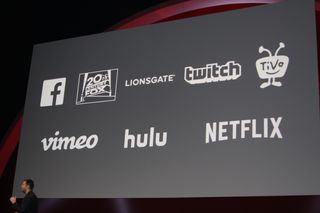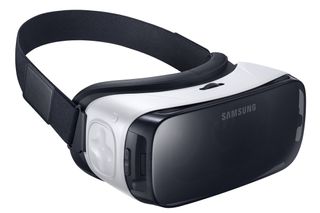Oculus Makes Mobile, Gear VR Its Entry-Level Play
Oculus and Samsung announced a new version of the Gear VR, and developers unleashed a banquet of new games and content for the platform at Oculus Connect 2, the company's annual developer conference that just concluded this week in Hollywood. I spent a fair amount of time with some of the new content during the event, and I also had a chance to talk with Max Cohen, who heads up the mobile efforts for Oculus.
In thinking about what I wanted to achieve at this year's event, besides feeding my growing addiction to virtual reality experiences, I plotted out a few key goals, one of which was to ascertain how Oculus plans to address the lower end of the buying market — that is, those for whom the first Rift will be out of reach.
I hope by now nobody here (meaning Tom's Hardware) is expecting the first Oculus Rift to be inexpensive, by which I mean the actual Rift and the system that will be required to run it. One industry executive I spoke with said that most insiders believe that only about 2 million people have systems that can run an Oculus Rift. That number is probably much too low, but no matter what the actual answer is, it's a narrow target for now.

As an aside, Oculus announced an Oculus Ready logo program which has the likes of Asus, Dell and Alienware shipping Rift-capable hardware for under $1,000, according to product VP Nate Mitchell. Clearly, Oculus is thinking about this.
Oculus further answered the question I wanted to ask ("What about the rest of us?") with Gear VR, the product Oculus has created with Samsung in a $199 Innovator Edition, and which runs VR apps powered by smartphones, or, more precisely, by flagship-level Samsung smartphones.
I always assumed the $199 Gear VR was a bit of a gimmick, something to satiate those who had to get their hands on VR right now, and another example of Samsung, which is notorious for throwing products against a wall to see what sticks, tossing out another trial balloon. It's clear now that Gear VR is the mass consumer version of the Oculus Rift. Period.

Oculus trotted Samsung mobile strategy chief Peter Koo to present a new Gear VR, which looks a lot like the old one, but it costs only $99. It will be available in time for Black Friday.
Stay On the Cutting Edge: Get the Tom's Hardware Newsletter
Join the experts who read Tom's Hardware for the inside track on enthusiast PC tech news — and have for over 25 years. We'll send breaking news and in-depth reviews of CPUs, GPUs, AI, maker hardware and more straight to your inbox.
The catch, of course, is that the new Gear VR only works with the latest (2015) Samsung flagship devices: the Note 5, the S6, the S6 Edge, the S6 Edge+ and whatever other iterations of those Samsung wants to toss at the walls. Note that some of these flagship smartphones start to push up into the same 4-digit price range of the aforementioned Oculus Ready PCs, so we'll leave it to our readers to decide whether Gear VR is for the masses or not.

Still, $99 sends a strong message. And Oculus and its partners have put some impressive work into the Gear VR ecosystem. When I first started using the Gear VR several months ago, my former colleague Don Woligroski handed it off to me and warned me not to underestimate it. And he was right. It was pretty interesting, but the content catalog was spartan. That catalog is growing, though, and the games and the content are even more compelling. I'll get to some of the games in a moment, but already you can now stream Netflix content to the current Gear VR, and Oculus has formed deals with Lionsgate, 20th Century Fox, Twitch, Hulu and Vimeo for more.
Gear VR Hardware
Let's start with the hardware, where Oculus has made a few subtle changes. Keep in mind that the Gear VR headset houses inertial measurement sensors for motion, but it doesn't include the constellation tracking for head tracking. Also keep in mind that because it's meant for mobile experiences, there are different design considerations.
For instance, whereas the Rift CV1 design features lightweight fabric, the Gear VR features much more of a helmet-ish plastic exterior, which makes it a bit heavier, but also a bit more rugged. In fact, some of the headset design must accommodate a smartphone on the front of the unit, whereas the CV1 doesn't have that burden. Nevertheless, Oculus was able to shave off some weight, and the new version will weigh 22 percent less than the current Innovator Edition. Gear VR also doesn't have integrated headphones, nor some of the electronics inside the CV1.

The new Gear VR locks into the smartphone with a mechanism that slides back to accommodate a large phone, but this will not accommodate other, older Samsung flagship smartphones. I suspected that maybe the Note 4, which uses an infamously hot-running Qualcomm SoC, was something Oculus wanted to avoid, but Cohen assured me that it was more of a physical fit issue. (Note: I have had multiple Gear VR thermal issues using the Note 4, but during the demonstrations using Galaxy S6 I ran into the same problem.)
The new facial interface for the Gear VR is wider to better accommodate eyeglasses, and its foam material has changed to better improve airflow (I can't tell you how often I've stopped playing simply because of heat and sweat). The strap is lighter and, according to Cohen, more comfortable, and the touch pad is further recessed and has ridges (you can see that in the picture above). Because you're flying blind, sometimes it's difficult to find the exact placement of the touch pad on the Innovator Edition, so this small change is a welcome one.
Oculus also supports this hardware with continual improvements to the Rift software and the mobile SDK. For example, developers can actually target GPU and CPU clocks speeds within their applications using APIs. This is where the Samsung relationship comes heavily into play, as the company has unlocked these processors. Just like the PC optimizations for VR, Oculus uses techniques like asynchronous time warp on the mobile side as well (but not late latch), and it supports thread priorities so that developers can ensure experiences aren't preempted by other processes.
The SDK also includes a multiview extension (enables a more efficient way to render to both eye buffers sequentially). Most of the SDK features are set, and the official 1.0 release (scheduled for November) is really just about making the APIs official (so that developers can update their apps dynamically) and making the SDK itself stable.
Gear VR Games
I spent well over an hour at Oculus Connect 2 playing just Gear VR games. That's probably the longest stint I've done on the device, but there was a lot more content, and many new games (mostly unavailable just yet). Before I get to a few tidbits on some of those games, I did spend a tiny bit of time in Arcade, which will be a new Gear VR environment providing old-school games like Sonic The Hedgehog, Gauntlet, SpyHunter and PacMan, just to name a few. I tried out Sonic for only about 30 seconds, but it was a delightful break from the typical VR games. The only VR-ish thing about this, of course, is the Arcade environment itself.
Similarly, watching live Twitch sessions and Netflix content was a 2D experience in a 3D setting. In Twitch, you're in a theater-style room, watching the content with other friends (represented as avatars), and you can speak to each other (and hear each other) and look at each other and so on. It gave the immersive experience slightly more of a social feeling, to be sure. I also watched a bit of a Bill Clinton VR video documentary featuring eastern Africa, and I found myself wishing I had more time for it, because it was visually spectacular.
Lands End, from Monument Valley, is one of the more interesting new games for Gear VR. The water and shadow effects, combined with the audio experience, makes for a serene immersion into a world of discovery and clever puzzle-solving that gets more complex as you go along. To move around each island, you essentially teleport using cues that appear when you look in just the right spot, and those same visual cues appear on puzzle pieces that you can manipulate: doors get unlocked through head movement gaze combinations, bridges appear, large structures fit together to enable movement to a new level. But perhaps the most amazing part is the sheer simplicity of it; there were no instructions, and it all just made sense.
Esper, from Coatsink, is another puzzle game that's been available on Gear VR, but we got to see a glimpse of Esper 2. Unfortunately I haven't played the first version, so I'm not sure what's different here, and I didn't get a chance to talk to anyone from Coatsink. But the main idea here is that you're using telekinesis to solve puzzles. You lift and move and throw objects using your gaze, but in an odd way it does in fact feel like you're using your brain to do this. A crafty idea. (One scene pictured below.)

And finally, the folks at CCP, makers of EVE: Valkyrie, were showing off a new Gear VR game called EVE: Gunjack, an FPS which feels quite a bit like Valkyrie. Here, you're operating a turret on a mining rig, and you've got to protect the rig from attack. Where you look, you're aimed to shoot. I ran out of time on this, but it's incredibly fun.
If you like shooting animals, Glu's Deer Hunter, also available on mobile platforms, might be fun. My brief time with it left me feeling a little underwhelmed. You walk into a field, gun loaded, scope into your target, use infrared (as if you need it), and fire away. Don't mistake this for an anti-hunting or anti-gun rant; it just feels a bit wrong, like you're over-matched, and when the animals die it's bizarre and pathetic -- almost too gleeful, I suppose.
There's so much more. As Don would say: Don't underestimate it. Or, think of Gear VR as another reason to talk yourself into a higher-end smartphone.
Fritz Nelson is the Editor-In-Chief of Tom's Hardware. Follow him on Twitter, Facebook and Google+. Follow Tom's Hardware on Twitter, Facebook and Google+.
Most Popular




